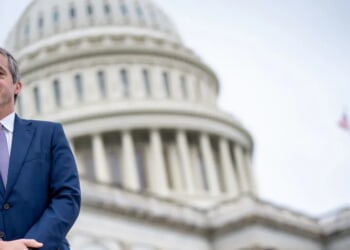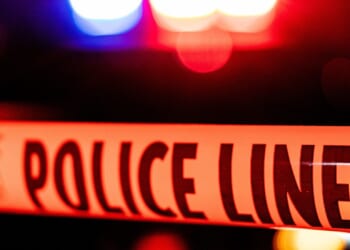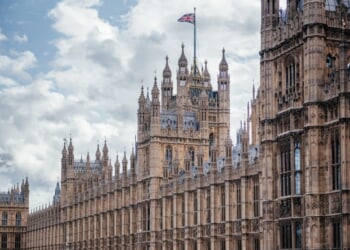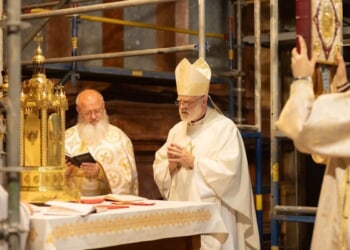“Once is happenstance. Twice is coincidence. Three times is enemy action.”
— Ian Fleming, Goldfinger
“…probabilities cannot be bribed to deceive, and … they cannot be convicted of bearing false witness.”
— Aristotle, Rhetoric, Book 1, Chapter 15
On July 13, 2024, 20-year-old Thomas Crooks, before witnesses and unimpeded by law enforcement, climbed onto the roof of the American Glass Research (AGR) building at the Butler Farm Show. He was 441 feet away from the stage on which candidate Donald Trump was addressing 15,000 enthusiastic supporters.
From that perch, Crooks used a semi-automatic rifle to rapidly fire eight rounds at the candidate. He killed Corey Imperatore and wounded three others who were on the stage.
One of the wounded was Trump, who turned his head a split second before Crooks opened fire. Consequently, instead of a lethal head shot, Crooks hit Trump in the fleshy part of the ear before being neutralized by a counter-sniper. (RELATED: Butler: The Riveting Untold Story of the Shooting of Donald Trump)
Crooks had come within a split second and a fraction of an inch of eliminating the man who was poised to resoundingly defeat President Joe Biden in the upcoming election.
Two weeks earlier, in a televised presidential debate, an incoherent Biden had conclusively and painfully demonstrated to the nation his total mental incapacity and utter unfitness for office. This had reduced the Democrat presidential electoral plan to shambles as Biden’s defeat appeared certain.
Trump had made clear that, once elected, he was going to dismantle the deep state, the federal bureaucracy, and otherwise upend the Washington power structure. He posed an existential threat to those who were profiting from their control of the federal leviathan and all who were feasting at the trough of taxpayer money.
Trillions of dollars were at stake.
Moreover, if Trump won, the Autopen Mafia that was secretly running the Biden regime would be exposed and quite likely face criminal prosecution.
Moreover, if Trump won, the Autopen Mafia that was secretly running the Biden regime would be exposed and quite likely face criminal prosecution for their outrageous and illegal usurpation of executive power. Similarly, all those in and out of government who had conspired to meretriciously smear, impeach, imprison, and otherwise destroy Trump were at dire risk. (RELATED: Autopen on Autopilot)
The stakes could not have been higher for these malefactors.
Trump had to be stopped at all costs.
But how would that be done? Trump’s opponents had tried to impeach and remove him from office, bankrupt him through bogus civil litigation, and imprison him for life through equally bogus criminal prosecutions. But by the time of the Butler rally, despite all of those efforts, Trump remained on track to win the election.
So what was left?
The answer to that question may be found in the recently released report of the General Accountability Office (GAO) to the Chairman of the Senate Committee on the Judiciary, and the report of the Senate Committee on Homeland Security and Governmental Affairs (HSGAC), which deal with the protection afforded Trump during his candidacy.
These parallel reports set forth a detailed narrative of official mismanagement, disorder, incompetence, and inexplicable failures that converged to afford Crooks the clear and readily preventable opportunity to murder Trump.
Consider the following points, which are taken from the reports.
In preparation for the rally, the Secret Service’s “site agent” was tasked with “identifying site vulnerabilities” at the Butler Farm Show grounds. But she was new to her role and testified that the rally was “her first time planning and securing a large outdoor event.” Which, of course, raises the question as to why this novice was not afforded direct supervision and advice as she inspected the Farm Show grounds and formulated a security plan.
As the site agent, she was responsible for identifying vulnerabilities (such as potential sniper locations), coordinating security responsibilities with local law enforcement, and ensuring the implementation of security measures, including perimeter set up and threat mitigation.
But this inexperienced site agent inexplicably failed to adequately provide for securing the AGR building rooftop. This despite the fact that the rooftop had a clear, unobstructed line of sight to the location where Trump would be speaking and which was a mere 441 feet away. From that range, a rifleman with even minimal shooting skills would have no problem killing Trump. As such, the rooftop was an open, glaringly obvious, and readily discernible “site vulnerability”.
Nevertheless, the site agent, as well as all the other Secret Service personnel who planned security, inexplicably failed to provide for securing the rooftop.
How could that happen?
Moreover, neither the site agent nor anyone else from the Secret Service planned for an adequate and properly equipped communications network by which warnings of detected threats and suspicious activities during the upcoming rally could be quickly and accurately conveyed to commanders on the scene.
In this regard, take a look at this timeline taken verbatim from the GAO report of events that unfolded during the rally.
5:14 pm: Beaver County snipers located inside the AGR building notice Crooks sitting on a small concrete wall.
5:38 pm: Beaver County snipers located inside the AGR building observed Crooks with a range finder [used by marksmen to determine distances to a target] and were asked to call it in to the local command post.
5:45 pm: Butler County officers radioed to be on the lookout for a young white male with blond hair and a backpack near the AGR building. Beaver County snipers and Butler Emergency Services Unit personnel sent photos of Crooks to the local command post and to Secret Service counter snipers.
5:49 pm: Butler County officers identified (sic) that the individual had a range finder and attempted to text pictures of the gunman, but experienced cell phone connectivity issues. As a result, they sent photos via email.
5:56 pm: Local law enforcement observed Crooks with a backpack.
6:00 pm: Local law enforcement observed Crooks near the AGR building.
6:08 pm: Crooks was observed on the roof of the AGR building.
6:11 pm: Local law enforcement officers observed Crooks with a long gun, and Crooks fired shots.
But, due to the Secret Service’s poorly planned and inadequately equipped communications network, the above observations never reached either the scene commanders or Trump’s Secret Service security detail — the Donald Trump Division (DTD) — who could have simply kept Trump off stage and hidden until Crooks was apprehended.
This chaos and lack of effective communications were further exacerbated by the Secret Service Headquarters’ denial of the DTD’s request to provide a so-called Counter Assault Team liaison to coordinate the efforts of agents and local law enforcement prior to the Butler rally.
Similarly, higher-ups in the Secret Service denied the DTD’s request for enhanced anti-drone systems for the outdoor event. Although a single anti-drone device was deployed at the rally, it malfunctioned, and its operator lacked the skill and technical knowledge to timely repair it. Consequently, the denial of the DTD’s request for multiple enhanced anti-drone systems resulted in Crooks being able to fly a drone near the Farm Show grounds to gather intelligence and plan his attack. It also left Trump vulnerable to attack with an explosive-laden drone.
Moreover, the denial of the DTD’s resource requests was not limited to the Butler event. Consider this summary from the HSGAC report:
According to USSS [Secret Service] documents provided to the Committee, USSS Headquarters denied or left unfulfilled at least 10 requests by the Donald Trump Division (DTD) for additional resources during the 2024 campaign including enhanced counter-unmannd aerial system (C-UAS) assets, counter assult team (CAT) personnel and counter sniper personnel. The documents revealed a pattern of certain categories of requests being either blatantly denied, unfulfilled, or required to be supplemented by local law-enforcement or other federal agencies, such as the Transportation Safety Administration (TSA), US Customs and Border Protection (CBP), and Homeland Security Investigations (HSI).
These denials of resources and slipshod planning become all the more curious in light of the fact that, 10 days prior to the Butler rally, while the Farm Show grounds were being inspected and the security plan was being formulated, senior Secret Service officials had been made aware of a specific “classified threat” to Trump’s life. And, even stranger, despite multiple opportunities to share this information, these senior officials failed to warn either the Secret Service’s Pittsburgh Field Office, the DTD, or the state and local law enforcement agencies that would be providing security at the event.
The Special Agent in Charge of the Secret Service’s Pittsburgh office stated that, had he been informed of the threat, he would have requested additional assets such as ballistic glass barriers for the stage, extra anti-drone coverage, and a full counter-sniper advance team. Similarly, local law enforcement agencies indicated that they would have sought more resources had they been made aware of the threat.
As for the withheld threat intelligence, the HSGAC report doesn’t give specifics. Instead, it provides this background of the general threat environment surrounding Trump:
On January 14, 2022, a video was posted on Grand Ayatollah Sayyid Ali Khamenei’s website depicting an animated drone strike targeting then former President Donald Trump playing golf at his Mar-a-Lago estate in West Palm Beach, Florida. President Trump and others in his first administration’s national security apparatus have long been targets of the Islamic Republic of Iran (Iran) for the U.S. role in a January 3, 2020 drone strike which killed Islamic Revolutionary Guard Corps (IRGC) General, Qasem Soleimani. The threats from Iran continued even after President Trump left office on January 20, 2021.
On July 12, 2024, one day before the Butler, Pennsylvania, campaign rally, the Federal Bureau of Investigation (FBI) arrested Asif Raza Merchant, a Pakistani national with ties to Iran and in the IRGC. According to the Department of Justice (DOJ) criminal complaint, after spending approximately two weeks in Iran, Merchant arrived in the U.S. in April 2024 to recruit an individual to assassinate U.S. political officials… After discussing the assassination plot with undercover federal law-enforcement officers, Merchant alluded to (sic) that he was “the ‘representative’ in the United States, indicating that there were other people he worked for outside the U.S.
The HSGAC report also discusses the DOJ criminal complaint against one Farhad Shakeri, an Afghan national living in Iran, who worked on behalf of the IRGC to hire two U.S. nationals to assassinate enemies of Iran. Among the targets was President Trump. As Shakeri told the FBI, the IRGC has long been targeting Trump for assassination.
All of which raises these questions:
- Why didn’t the Secret Service leadership share the specific “classified threat” to Trump’s life with the Secret Service personnel tasked with protecting Trump? The proffered explanation attributes this failure to the Secret Service’s policy of restricting distribution of “siloed” classified information to the higher-ups in the agency. But that makes no sense. After all, what good is it to possess “classified information” but not use it?
- Is this purported policy to protect “siloed” classified information the real and only reason the threat intelligence wasn’t shared with the agents in the field? Or is it just a cover story calculated to justify what otherwise appears to be a deliberate effort to hamper the efforts of the agents tasked with protecting Trump?
- Is there an innocent, non-culpable, and rational purpose for withholding this information? If so, what is it?
And finally, it should be noted that Kimberly Cheatle, who was director of the Secret Service before, during, and after the Butler fiasco, was appointed to that post by none other than Joe Biden, who, along with his son and brother, was at serious risk of criminal investigation and prosecution if Trump became president. It is also of note that, according to the HSGAC report, Cheatle “falsely testified to Congress that no USSS asset requests were denied for the Butler rally.”
Now, why would she swear to that?
So let’s sum up. Under the leadership of a director appointed by Joe Biden, Secret Service Headquarters withheld intelligence about a specific threat against Trump’s life, denied requested resources for his protection, and allowed a poorly-planned, under-resourced, incompetent, and disorganized protection plan to be implemented at the Butler rally. And this behavior was characteristic of the leadership’s handling of Trump’s security throughout the campaign.
Were these actions and Trump’s resulting near-death just a matter of happenstance and incompetence? Were they just a series of actions that coincidentally produced an unfortunate and unintended risk to Trump’s life?
Or were they intentionally orchestrated to increase the chances that Trump would be assassinated?
In other words, what are the probabilities or odds that all of these curious and perplexing actions by the Secret Service converged by mere coincidence to afford Thomas Crooks an obvious and readily preventable opportunity to murder Trump?
George Parry is a former federal and state prosecutor. He blogs at knowledgeisgood.net.
READ MORE from George Parry:
The Wages of COVID — Part Three


![Former Bravo Star Charged After Violent Assault Using a Rock-Filled Sock in Tennessee Walmart [WATCH]](https://www.right2024.com/wp-content/uploads/2025/07/Former-Bravo-Star-Charged-After-Violent-Assault-Using-a-Rock-Filled-350x250.jpg)



![Illegal Alien Walked Free After Decapitating Woman, Abusing Corpse for Weeks [WATCH]](https://www.right2024.com/wp-content/uploads/2025/07/1753013138_Illegal-Alien-Walked-Free-After-Decapitating-Woman-Abusing-Corpse-for-350x250.jpg)
![NYC Man Snatches Child Off The Sidewalk, Parents Chase Him Down [WATCH]](https://www.right2024.com/wp-content/uploads/2025/07/NYC-Man-Snatches-Child-Off-The-Sidewalk-Parents-Chase-Him-350x250.jpg)
![Man Arrested After Screaming at Senators During Big Beautiful Bill Debate [WATCH]](https://www.right2024.com/wp-content/uploads/2025/06/Man-Arrested-After-Screaming-at-Senators-During-Big-Beautiful-Bill-350x250.jpg)
![Karoline Leavitt Levels CNN's Kaitlan Collins and Other Legacy Media Reporters [WATCH]](https://www.right2024.com/wp-content/uploads/2025/07/Karoline-Leavitt-Levels-CNNs-Kaitlan-Collins-and-Other-Legacy-Media-350x250.jpg)
![Leftists Lose Their Minds After Jason Kelce Celebrates Being an American [WATCH]](https://www.right2024.com/wp-content/uploads/2025/07/Leftists-Lose-Their-Minds-After-Jason-Kelce-Celebrates-Being-an-350x250.jpg)





